Life Cycle Assessment Comparison between an Earthbag Building and a Conventional Sahrawi Cement Blocks Building
Abstract
:1. Introduction
1.1. Life Cycle Assessment
1.2. LCA in Earthen Construction
- -
- The lack of comparison with standard materials and techniques makes it difficult to draw eco-friendly guidelines.
- -
- These individual Life Cycle Assessment (LCA) studies cannot be easily compared, because they use site-specific and material/process-specific data unique to each study.
- -
- The lack of uniformity when considering the functional unit does not enable direct comparisons between different construction techniques. Functional units, such as 1 kg of material [10], 1 m2 wall [20,21], or specific samples like a brick [13,15], are found in the literature. In order to compare those techniques, a common functional unit should be used.
2. Materials and Methods
2.1. Buildings Description
2.2. Scope
2.3. Life Cycle Inventory, Impact Assessments, and Simapro Software
3. Results and Discussion
4. Conclusions
Author Contributions
Funding
Data Availability Statement
Acknowledgments
Conflicts of Interest
References
- Labaran, Y.H.; Mathur, V.S.; Muhammad, S.U.; Musa, A.A. Carbon footprint management: A review of construction industry. Clean. Eng. Technol. 2022, 9, 100531. [Google Scholar] [CrossRef]
- Barbhuiya, S.; Das, B.B. Life Cycle Assessment of construction materials: Methodologies, applications and future directions for sustainable decision-making. Case Stud. Constr. Mater. 2023, 19, e02326. [Google Scholar] [CrossRef]
- Mostafaei, H.; Keshavarz, Z.; Rostampour, M.A.; Mostofinejad, D.; Wu, C. Sustainability Evaluation of a Concrete Gravity Dam: Life Cycle Assessment, Carbon Footprint Analysis, and Life Cycle Costing. Structures 2023, 53, 279–295. [Google Scholar] [CrossRef]
- Khasreen, M.M.; Banfill, P.F.G.; Menzies, G.F. Life-Cycle Assessment and the Environmental Impact of Buildings: A Review. Sustainability 2009, 1, 674–701. [Google Scholar] [CrossRef]
- Ortiz, O.; Castells, F.; Sonnemann, G. Sustainability in the construction industry: A review of recent developments based on LCA. Constr. Build. Mater. 2009, 23, 28–39. [Google Scholar] [CrossRef]
- Martínez-Rocamora, A.; Solís-Guzmán, J.; Marrero, M. LCA databases focused on construction materials: A review. Renew. Sustain. Energy Rev. 2016, 58, 565–573. [Google Scholar] [CrossRef]
- Asdrubali, F.; Baldassarri, C.; Fthenakis, V. Life cycle analysis in the construction sector: Guiding the optimization of conventional Italian buildings. Energy Build. 2013, 64, 73–89. [Google Scholar] [CrossRef]
- Salvador, R.; Barros, M.V.; dos Santos, G.E.T.; van Mierlo, K.G.; Piekarski, C.M.; de Francisco, A.C. Towards a green and fast production system: Integrating life cycle assessment and value stream mapping for decision making. Environ. Impact Assess. Rev. 2021, 87, 106519. [Google Scholar] [CrossRef]
- Schroeder, H. The Future of Earth Building. In Sustainable Building with Earth; Springer: Berlin/Heidelberg, Germany, 2016; pp. 527–540. Available online: https://link.springer.com/chapter/10.1007/978-3-319-19491-2_7 (accessed on 5 February 2024).
- Christoforou, E.; Kylili, A.; Fokaides, P.A.; Ioannou, I. Cradle to site Life Cycle Assessment (LCA) of adobe bricks. J. Clean. Prod. 2016, 112, 443–452. [Google Scholar] [CrossRef]
- Shukla, A.; Tiwari, G.; Sodha, M. Embodied energy analysis of adobe house. Renew. Energy 2009, 34, 755–761. [Google Scholar] [CrossRef]
- Treloar, G.J.; Owen, C.; Fay, R. Environmental assessment of rammed earth construction systems. Struct. Surv. 2001, 19, 99–106. [Google Scholar] [CrossRef]
- Serrano, S.; Barreneche, C.; Rincón, L.; Boer, D.; Cabeza, L.F. Stabilized rammed earth incorporating PCM: Optimization and improvement of thermal properties and Life Cycle Assessment. Energy Procedia 2012, 30, 461–470. [Google Scholar] [CrossRef]
- Nouri, H.; Safehian, M.; Hosseini, S.M.M.M. Life cycle assessment of earthen materials for low-cost housing a comparison between rammed earth and fired clay bricks. Int. J. Build. Pathol. Adapt. 2023, 41, 364–377. [Google Scholar] [CrossRef]
- Mateus, R.; Fernandes, J.; Teixeira, E.R. Environmental Life Cycle Analysis of Earthen Building Materials. In Encyclopedia of Renewable and Sustainable Materials; Elsevier: Amsterdam, The Netherlands, 2020; pp. 63–68. [Google Scholar] [CrossRef]
- Fernandes, J.; Peixoto, M.; Mateus, R.; Gervásio, H. Life cycle analysis of environmental impacts of earthen materials in the Portuguese context: Rammed earth and compressed earth blocks. J. Clean. Prod. 2019, 241, 118286. [Google Scholar] [CrossRef]
- Lavrik, L.; Losini, A.E.; Stampino, P.G.; Caruso, M.; Grillet, A.-C.; Woloszyn, M. Comparative Life Cycle Assessment of Rammed Earth Stabilized with Different Biopolymers. In Bio-Based Building Materials; RILEM Bookseries; Springer: Berlin/Heidelberg, Germany, 2023; Volume 45, pp. 1012–1032. [Google Scholar] [CrossRef]
- Serrano, S.; Barreneche, C.; Rincón, L.; Boer, D.; Cabeza, L.F. Optimization of three new compositions of stabilized rammed earth incorporating PCM: Thermal properties characterization and LCA. Constr. Build. Mater. 2013, 47, 872–878. [Google Scholar] [CrossRef]
- Morel, J.; Mesbah, A.; Oggero, M.; Walker, P. Building houses with local materials: Means to drastically reduce the environmental impact of construction. J. Affect. Disord. 2001, 36, 1119–1126. [Google Scholar] [CrossRef]
- Melià, P.; Ruggieri, G.; Sabbadini, S.; Dotelli, G. Environmental impacts of natural and conventional building materials: A case study on earth plasters. J. Clean. Prod. 2014, 80, 179–186. [Google Scholar] [CrossRef]
- Ben-Alon, L.; Loftness, V.; Harries, K.A.; DiPietro, G.; Hameen, E.C. Cradle to site Life Cycle Assessment (LCA) of natural vs conventional building materials: A case study on cob earthen material. Build. Environ. 2019, 160, 106150. [Google Scholar] [CrossRef]
- Li, J.; Gray, M.; Coulter, S. An Investigation into the Use of Cob and/or Straw Bale Construction in Non-Residential Buildings; University of British Columbia: Vancouver, BC, Canada, 2014. [Google Scholar]
- Cataldo-Born, M.; Araya-Letelier, G.; Pabón, C. Obstacles and motivations for earthbag social housing in Chile: Energy, environment, economic and codes implications. Rev. Constr. 2016, 15, 17–26. [Google Scholar] [CrossRef]
- Dormohamadi, M.; Rahimnia, R.; Bunster, V. Life cycle assessment and life cycle cost analysis of different walling materials with an environmental approach (comparison between earth-based vs. conventional construction techniques in Iran). Int. J. Life Cycle Assess. 2023. [Google Scholar] [CrossRef]
- Rincón, L.; Carrobé, A.; Medrano, M.; Solé, C.; Castell, A.; Martorell, I. Analysis of the Thermal Behavior of an Earthbag Building in Mediterranean Continental Climate: Monitoring and Simulation. Energies 2019, 13, 162. [Google Scholar] [CrossRef]
- Rincón, L.; Carrobé, A.; Martorell, I.; Medrano, M. Improving thermal comfort of earthen dwellings in sub-Saharan Africa with passive design. J. Build. Eng. 2019, 24, 100732. [Google Scholar] [CrossRef]
- Ugochukwu, S.C.; Nwobu, E.A.; Udechukwu-Ukohah, E.I.; Odenigbo, O.G.; Ekweozor, E.C. Regression Models for Predicting Quantities and Estimates of Steel Reinforcements in Concrete Beams of Frame Buildings. J. Sci. Res. Rep. 2020, 26, 60–74. [Google Scholar] [CrossRef]
- Ministerio de Fomento. Código Técnico de la Edificación (CTE) Documento Básico de Seguridad Estructural: Fábrica (SE-F). Diciembre 2019. Available online: https://www.codigotecnico.org/pdf/Documentos/SE/DBSE-F.pdf (accessed on 5 February 2024).
- Huijbregts, M.A.; Steinmann, Z.J.; Elshout, P.M.; Stam, G.; Verones, F.; Vieira, M.D.; Hollander, A.; Zijp, M.; van Zelm, R. ReCiPe 2016 v1.1 A Harmonized Life Cycle Impact Assessment Method at Midpoint and Endpoint Level Report I: Characterization; National Institute for Public Health and the Environment: Bilthoven, The Netherlands, 2016. [Google Scholar]
- Silva, D.A.L.; Nunes, A.O. How Important is the LCA Software Tool You Choose? Comparative Results from GaBi, openLCA, SimaPro and Umberto. In Proceedings of the VII Conferencia Internacional de Análisis de Ciclo de Vida en Latinoamérica, Medellin, Colombia, 10–15 June 2017. [Google Scholar]
- Familia ISO 14000; Gestión Ambiental. Available online: https://www.iso.org/es/normas/mas-comunes/familia-iso-14000 (accessed on 5 February 2024).
- Soto, J.L.; López-Para, P.R.; Ruiz, J.R.S.; Pérez, M.G. Análisis comparativo del impacto ambiental de componentes de transformadores eléctricos. In Comunicaciones Presentadas al VI Congreso Internacional de Proyectos de Ingeniería: Celebrado en Barcelona del 23 al 25 de Octubre de 2002; Asociación Española de Ingeniería de Proyectos (AEIPRO), 2002; p. 42. ISBN 84-600-9800-1. Available online: https://dialnet.unirioja.es/servlet/articulo?codigo=8428088 (accessed on 5 February 2024).
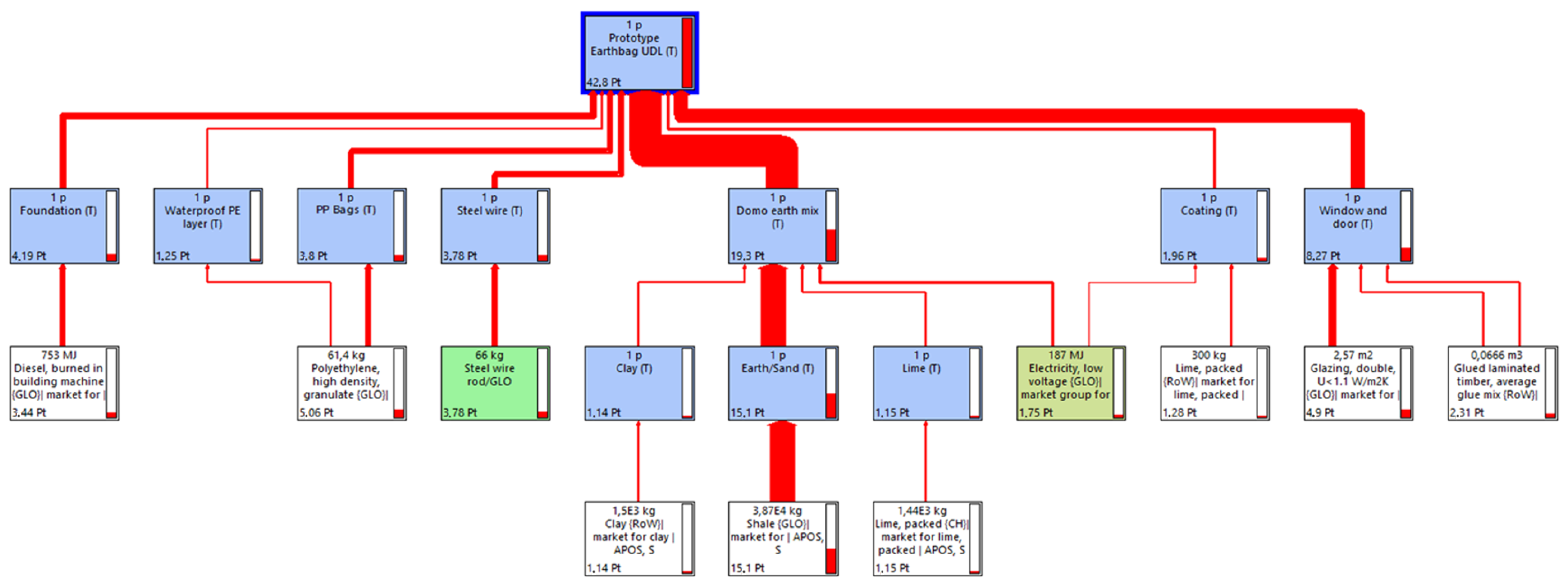
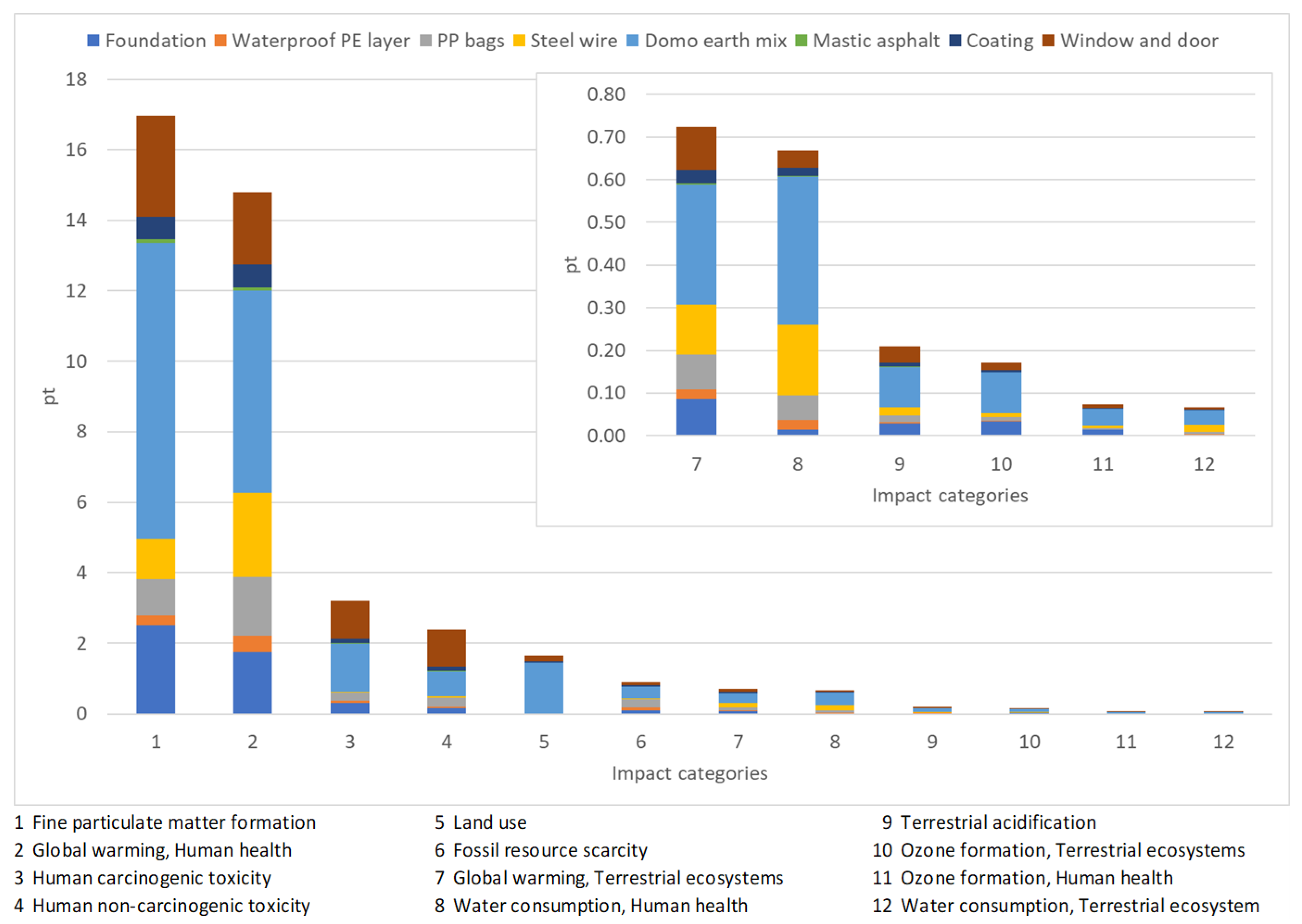

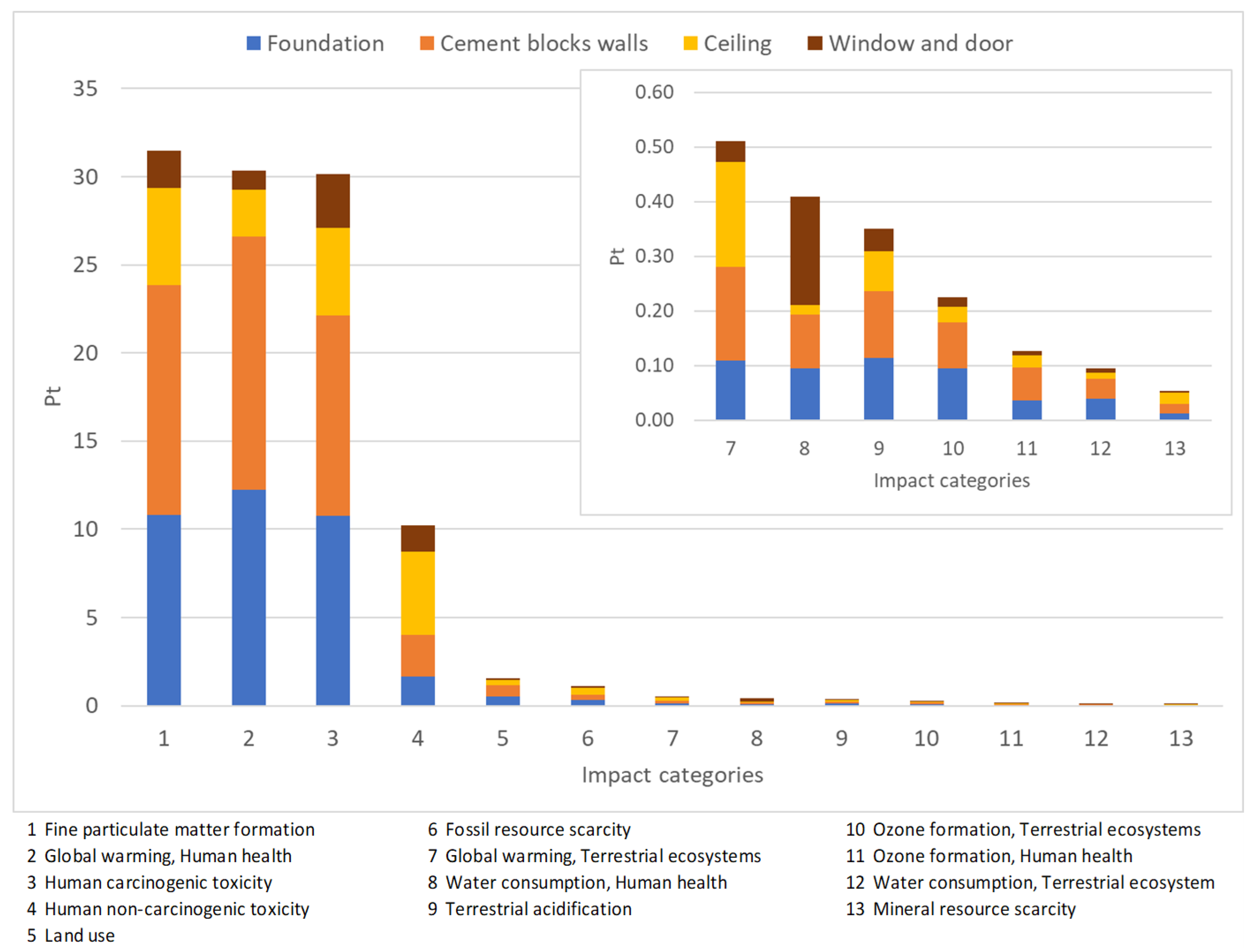
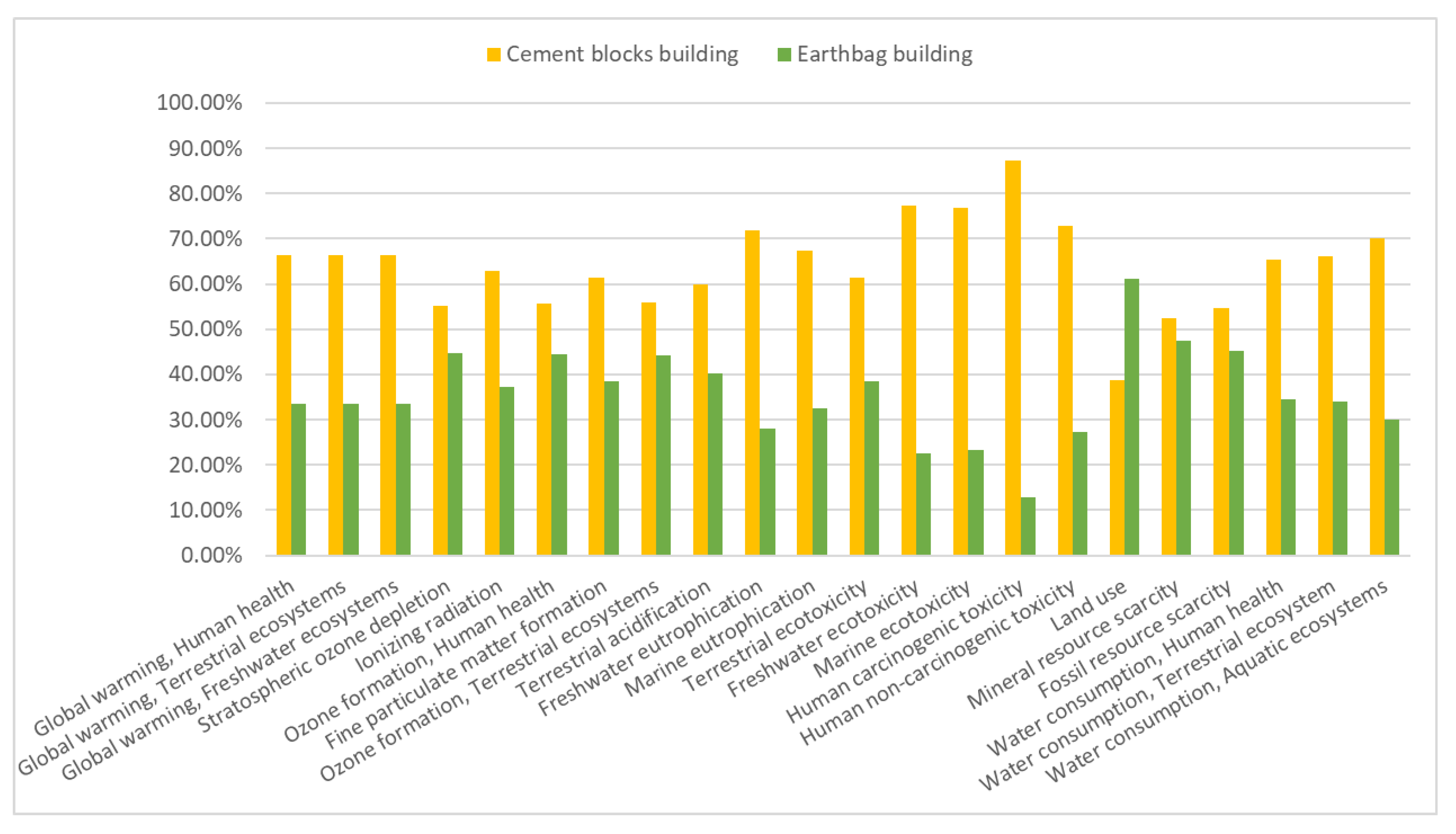
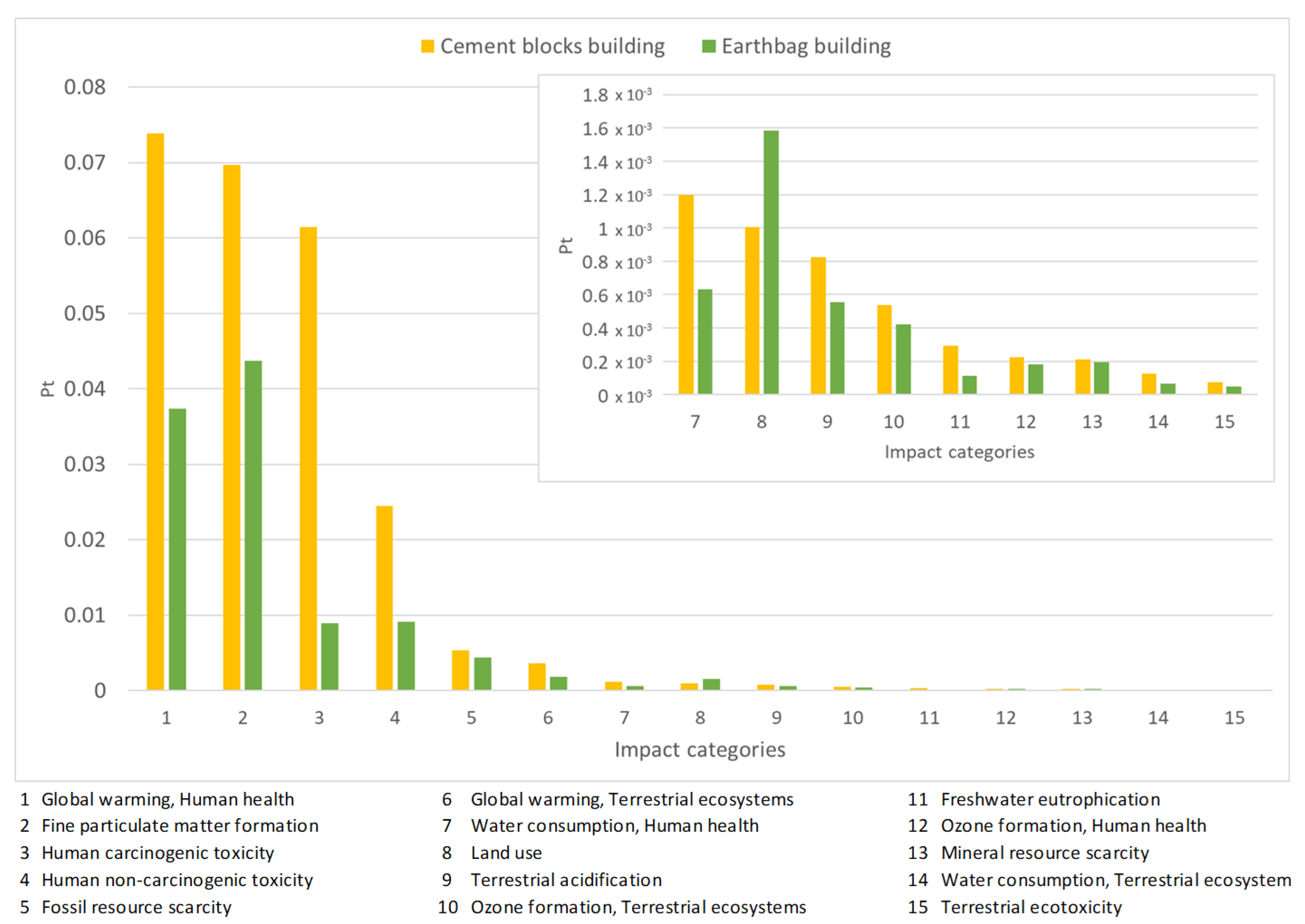
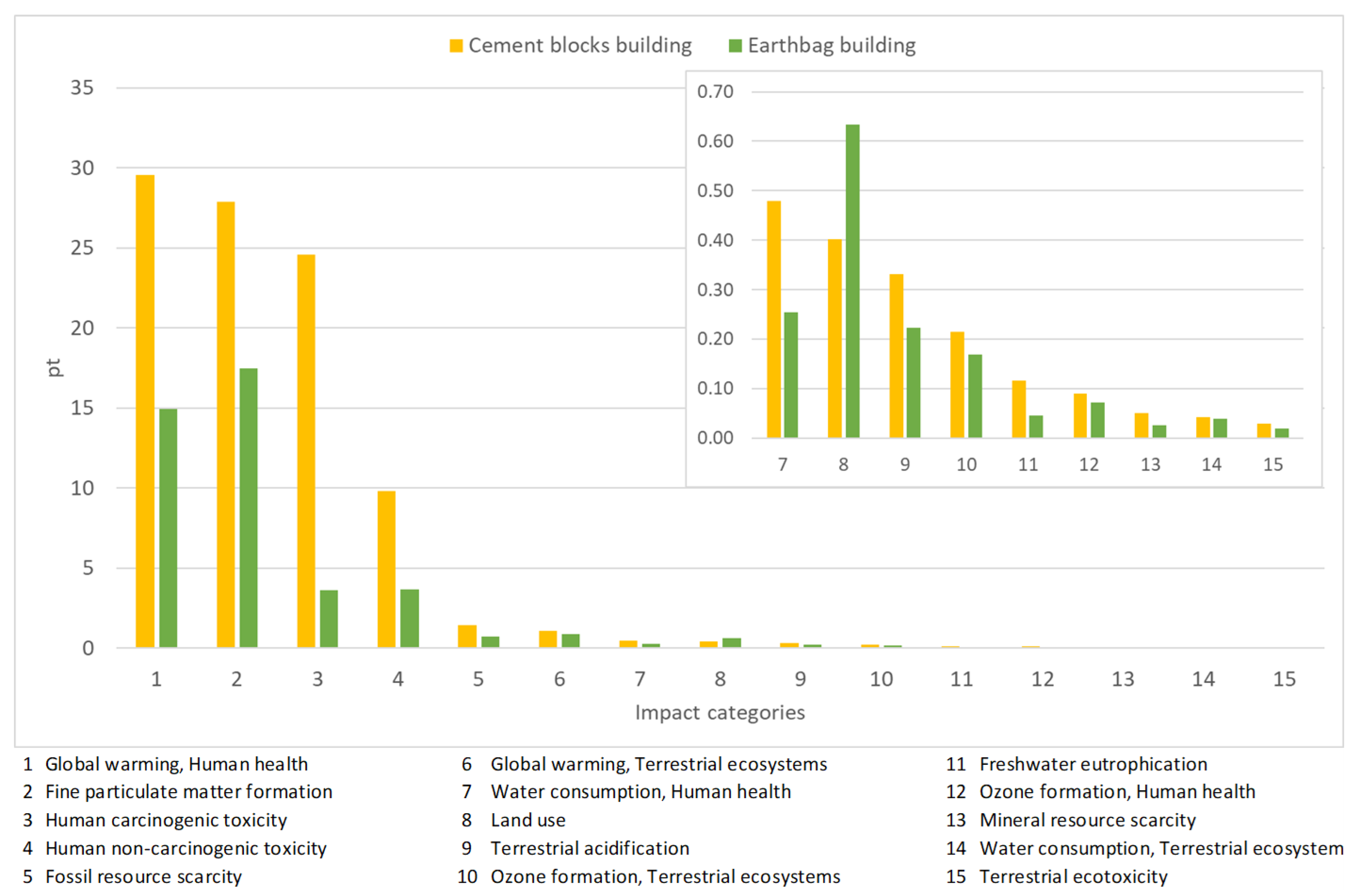

| Earthbag Building | Cement Blocks Building | |
|---|---|---|
| Type of construction | 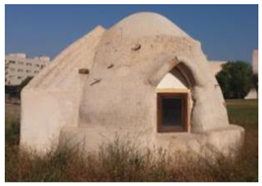 | 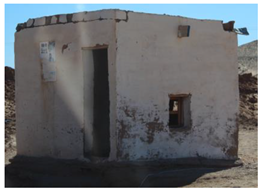 |
| Volume shape | Dome shape | Cube shape |
| Inner net surface | 7.07 m2 | 7.05 m2 |
| Height | 3.3 m (maximum) | 2.5 m |
| Inner net volume | 17.67 m3 | 17.63 m3 |
| Door | Exterior frame measuring 0.91 m × 2 m, with a glazed area of 1.09 m2 and a wooden frame of 6 cm. | |
| Windows | Two windows measuring 0.8 × 0.67 m (east) and 0.6 × 0.35 m (west), which represent a glazed area of 0.25 m2 and 0.21 m2, respectively. | |
| Main construction materials | Earth mixture consists of 0.80% fine gravel, 92.21% sand, 3.42% slime, and 3.57% clay by weight. | Cement blocks 40 × 20 × 15 cm (BL1550), cement mortar, reinforced steel bars, and aluminum sandwich panels. |
| Assembly | Quantity | Unit | Simapro Reference |
|---|---|---|---|
| Clay | |||
| 1498.68 | kg | Clay {RoW}|market for clay|APOS, S | |
| Earth/Sand | |||
| 38,709 | kg | Shale {GLO}|market for|APOS, S | |
| Lime | |||
| 1435.72 | kg | Lime, packed {CH}|market for lime, packed|APOS, S | |
| Domo earth mix | |||
| 1 | p | Clay | |
| 1 | p | Earth/Sand | |
| 1 | p | Lime | |
| 16,792 | kg | Water, harvested from rainwater {GLO}|rainwater harvesting|APOS, S | |
| 51 | kWh | Electricity, low voltage {ES}|electricity voltage transformation from medium to low voltage|APOS, S | |
| Foundation | |||
| 1000 | kg | Gravel, crushed {RoW}|market for gravel, crushed|APOS, S | |
| 752.8 | MJ | Diesel, burned in building machine {GLO}|market for|APOS, S | |
| Mastic asphalt | |||
| 20 | kg | Mastic asphalt {GLO}|market for|APOS, S | |
| Waterproof PE layer | |||
| 15.24 | kg | Polyethylene, high density, granulate {GLO}|market for|APOS, S | |
| PP bags | |||
| 46.2 | kg | Polypropylene, high density, granulate {GLO}|market for|APOS, S | |
| Steel wire | |||
| 66 | kg | Steel wire rod/EU | |
| Window/Door | |||
| 2.566 | m2 | Glazing, double, U < 1.1 W/m2K {RER}|production|APOS, S | |
| 0.022 | m3 | Oriented strand board {RER}|production|APOS, S | |
| 4 | kg | Polystyrene foam slab for perimeter insulation {RoW}|processing|APOS, S | |
| 0.0666 | m3 | Glued laminated timber, average glue mix {Europe without Switzerland}|glued laminated timber production, average glue mix|APOS, S | |
| Coating | |||
| 339.3 | kg | Water, harvested from rainwater {GLO}|market for water, harvested from rainwater|APOS, S | |
| 1000 | kg | Sand {RoW}|market for sand|APOS, S | |
| 300 | kg | Lime {RER}|market for lime|APOS, S | |
| 2 | kWh | Electricity, low voltage {ES}|electricity voltage transformation from medium to low voltage|APOS, S | |
| Earthbag construction | |||
| 1 | p | Domo earth mix | |
| 1 | p | Foundation | |
| 1 | p | Mastic asphalt | |
| 1 | p | Waterproof PE layer | |
| 1 | p | PP bags | |
| 1 | p | Steel wire | |
| 1 | p | Window/Door | |
| 1 | p | Coating | |
| Assembly | Quantity | Unit | Simapro Reference |
|---|---|---|---|
| Ceiling | |||
| 67.76 | kg | Polystyrene foam slab, 10% recycled {GLO}|market for|APOS, S | |
| 22.032 | kg | Aluminium alloy, metal matrix composite {GLO}|market for|APOS, S | |
| Cement blocks walls | |||
| 2596 | kg | Concrete block {RoW}|market for concrete block|APOS, S | |
| 622 | kg | Cement mortar {RoW}|market for cement mortar|APOS, S | |
| 300 | kg | Water, harvested from rainwater {GLO}|market for water, harvested from rainwater|APOS, S | |
| 65.62 | kg | Reinforcing steel {GLO}|market for|APOS, S | |
| Foundation | |||
| 1000 | kg | Gravel, crushed {RoW}|market for gravel, crushed|APOS, S | |
| 1.5 | m3 | Concrete, 20 MPa {RoW}|market for concrete, 20 MPa|APOS, S | |
| 112.5 | kg | Reinforcing steel {GLO}|market for|APOS, S | |
| 752 | MJ | Diesel, burned in building machine {GLO}|market for|APOS, S | |
| Window/Door | |||
| 2.566 | m2 | Glazing, double, U < 1.1 W/m2K {GLO}|market for|APOS, S | |
| 0.022 | m3 | Oriented strand board {RoW}|market for oriented strand board|APOS, S | |
| 4 | kg | Polystyrene foam slab for perimeter insulation {GLO}|market for|APOS, S | |
| 0.0666 | m3 | Glued laminated timber, average glue mix {RoW}|market for glued laminated timber, average glue mix|APOS, S | |
| Cement Blocks Building | |||
| 1 | p | Foundation | |
| 1 | p | Cement blocks walls | |
| 1 | p | Ceiling | |
| 1 | p | Window and door | |
| Impact Category Number | Midpoint Impact Category | Normalisation | Ponderation | Impact Difference | ||
|---|---|---|---|---|---|---|
| CBB | EB | CBB | EB | |||
| 1 | Global warming, Human health | 7.38 × 10−2 | 3.73 × 10−2 | 29.54 | 14.93 | 49.45% |
| 2 | Fine particulate matter formation | 6.97 × 10−2 | 4.37 × 10−2 | 27.87 | 17.47 | 37.32% |
| 3 | Human carcinogenic toxicity | 6.14 × 10−2 | 8.97 × 10−3 | 24.57 | 3.59 | 85.40% |
| 4 | Human non-carcinogenic toxicity | 2.45 × 10−2 | 9.15 × 10−3 | 9.79 | 3.66 | 62.59% |
| 5 | Global warming, Terrestrial ecosystems | 3.61 × 10−3 | 1.83 × 10−3 | 1.44 | 7.3 × 10−1 | 49.45% |
| 6 | Fossil resource scarcity | 5.35 × 10−3 | 4.42 × 10−3 | 1.07 | 8.8 × 10−1 | 17.45% |
| 7 | Water consumption, Human health | 1.20 × 10−3 | 6.34 × 10−4 | 4.8 × 10−1 | 2.5 × 10−1 | 47.09% |
| 8 | Land use | 1.01 × 10−3 | 1.59 × 10−3 | 4.0 × 10−1 | 6.3 × 10−1 | −57.40% |
| 9 | Terrestrial acidification | 8.27 × 10−4 | 5.56 × 10−4 | 3.3 × 10−1 | 2.2 × 10−1 | 32.75% |
| 10 | Ozone formation, Terrestrial ecosystems | 5.36 × 10−4 | 4.23 × 10−4 | 2.1 × 10−1 | 1.7 × 10−1 | 21.04% |
| 11 | Freshwater eutrophication | 2.91 × 10−4 | 1.14 × 10−4 | 1.2 × 10−1 | 5.0 × 10−2 | 60.90% |
| 12 | Ozone formation, Human health | 2.26 × 10−4 | 1.80 × 10−4 | 9.04 × 10−2 | 7.21 × 10−2 | 20.24% |
| 13 | Water consumption, Terrestrial ecosystem | 1.28 × 10−4 | 6.56 × 10−5 | 5.11 × 10−2 | 2.62 × 10−2 | 48.64% |
| 14 | Mineral resource scarcity | 2.12 × 10−4 | 1.92 × 10−4 | 4.24 × 10−2 | 3.85 × 10−2 | 9.24% |
| 15 | Terrestrial ecotoxicity | 7.49 × 10−1 | 4.70 × 10−5 | 3.00 × 10−2 | 1.88 × 10−2 | 37.30% |
| 16 | Freshwater ecotoxicity | 5.52 × 10−5 | 1.61 × 10−5 | 2.21 × 10−2 | 6.44 × 10−3 | 70.85% |
| 17 | Ionizing radiation | 1.93 × 10−5 | 1.14 × 10−5 | 7.73 × 10−3 | 4.57 × 10−3 | 40.85% |
| 18 | Marine ecotoxicity | 1.14 × 10−5 | 3.45 × 10−6 | 4.57 × 10−3 | 1.38 × 10−3 | 69.78% |
| 19 | Stratospheric ozone depletion | 1.07 × 10−1 | 8.65 × 10−6 | 4.27 × 10−3 | 3.46 × 10−3 | 18.99% |
| 20 | Global warming, Freshwater ecosystems | 9.87 × 10−4 | 4.99 × 10−8 | 3.95 × 10−6 | 1.99 × 10−5 | 49.45% |
| 21 | Marine eutrophication | 5.48 × 10−8 | 2.65 × 10−8 | 2.19 × 10−6 | 1.06 × 10−5 | 51.73% |
| 22 | Water consumption, Aquatic ecosystems | 1.06 × 10−8 | 4.54 × 10−9 | 4.25 × 10−6 | 1.82 × 10−6 | 57.30% |
Disclaimer/Publisher’s Note: The statements, opinions and data contained in all publications are solely those of the individual author(s) and contributor(s) and not of MDPI and/or the editor(s). MDPI and/or the editor(s) disclaim responsibility for any injury to people or property resulting from any ideas, methods, instructions or products referred to in the content. |
© 2024 by the authors. Licensee MDPI, Basel, Switzerland. This article is an open access article distributed under the terms and conditions of the Creative Commons Attribution (CC BY) license (https://creativecommons.org/licenses/by/4.0/).
Share and Cite
Carrobé, A.; Castell, A.; Martorell, I. Life Cycle Assessment Comparison between an Earthbag Building and a Conventional Sahrawi Cement Blocks Building. Materials 2024, 17, 1011. https://doi.org/10.3390/ma17051011
Carrobé A, Castell A, Martorell I. Life Cycle Assessment Comparison between an Earthbag Building and a Conventional Sahrawi Cement Blocks Building. Materials. 2024; 17(5):1011. https://doi.org/10.3390/ma17051011
Chicago/Turabian StyleCarrobé, Ariadna, Albert Castell, and Ingrid Martorell. 2024. "Life Cycle Assessment Comparison between an Earthbag Building and a Conventional Sahrawi Cement Blocks Building" Materials 17, no. 5: 1011. https://doi.org/10.3390/ma17051011





